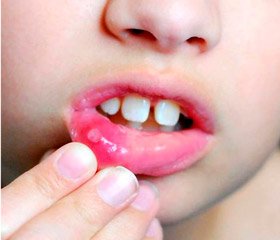Журнал «Здоровье ребенка» 3 (63) 2015
Вернуться к номеру
Viral stomatitis
Авторы: Mavrutenkov V.V. — Department of infectious diseases of SE “Dnipropetrovsk medical academy of Health ministry of Ukraine”, Dnipropetrovsk city, Ukraine
Рубрики: Педиатрия/Неонатология
Разделы: Клинические исследования
Версия для печати
Stomatitis is the inflammation of the oral mucosa caused by local or systemic factors, which can involve the mucous membrane of the cheeks and lips, palate, tongue, mouth floor and gums. Сauses of vesicles and aphthae appearance on the oral mucosa include trauma, infections, autoimmune processes, tumors. Recurrent aphthous stomatitis is idiopathic.
Thus the lesions of oral mucosa can have interdisciplinary character, and not only dentists, but also doctors of other specialties are involved for diagnosis of stomatitis reasons.
For rash description on the oral mucosa dermatological terms are used, which provide the assessment of rash sizes and character. The distinctive element for stomatitis is the aphthae [from Latin, Greek “thrush”], the small ulcer represented with round form lesion with grayish exudate surrounded with a red nimbus typical for recurrent aphthous stomatitis.
The term of “Aphthae” was invented by Hippocrates, who implied mouth thrush by that term.
In 1888 J. von Mikulicz-radecki and W. Kümmel implemented a concept of “Minor Aphthae” into the clinical practice.
In 1911 American dermatologist R. L. Sutton described large forms of aphthae, which allowed to assign the eponym of illness of Sattona to recurrent aphthous stomatitis.
The purpose of work is the improvement of clinical diagnosis and management of viral stomatites on the basis of modern conception of an etiology and pathogenesis of viral infections.
Current work does not consider aspects of congenital, for example, Navajo syndrome, and acquired immunodeficiencies (immunosuppressive chemotherapy, HIV infection).
In terms of topical diagnosis, the presence of vesicles and aphthae (pathognomic sign) makes the diagnosis of stomatitis definitive. However, morphological assessment of aphthous-vesicular lesions of the oral mucosa does not answer the main question of diagnosis, the cause of stomatitis. Algorithm of differential diagnosis of cause determination of the vesicles / aphthae must rely on the following predictors: 1) presence of extrapharyngeal symptoms and signs, 2) presence of fever, 3) first episode or recurrence (stereotype manifestations), 4) age and ethnicity of the patient, 5) epidemic situation in the region and the vaccination status of the patient. In this case, all of the above mentioned factors should be considered in the overall context. The article discusses the most common viral infection in which stomatitis is either clinical for or one of the existing syndromes: herpes simplex virus types 1 + 2, varicella-herpes zoster virus, enterovirus (echovirus, Coxsackie A and B, type 71) and measles. Furthermore, the occurrence of stomatitis is possible at diseases caused by vesicular stomatitis virus, HIV, human herpes virus type 6 and Epstein-Barr virus. Herpetic gingivostomatitis, or non-epidemic stomatitis, caused by HSV type 1 + 2 has two variants, primary infection and recurrence of latent infection. Primary infection manifests with vesicular stomatitis in combination with systemic manifestations (fever, irritability, cervical lymphadenopathy), possible complications, which require mandatory prescription of antiviral chemotherapy. Cheilitis is the most common form of recurrent HSV types 1 + 2 infection it is not accompanied by systemic manifestations. In pediatrics criteria for acyclovir prescription for prevention of recurrent herpetic stomatitis are not precisely defined. Whereas, for children over 12 years of age (> 42 kg) and adults chemoprophylaxis is recommended if ≥6 laboratory documented relapses of stomatitis occur per year. Enteroviruses are the second most important causes of stomatitis, which are characterized by seasonality (summer - autumn) and group incidence. Enteroviral stomatitis can manifest in the form of gerpangina and hand-foot-mouth disease. At these diseases etiotropic chemotherapy and immune prophylaxis are absent. Varicella-zoster virus infection is an antroponous α-herpesvirus type III. In the case of primary infection it causes chicken pox (varicella), in reactivation it causes herpes zoster. Varicella stomatitis is a characteristic feature, whereas at herpes zoster it is a rare phenomenon. Quarantine and treatment of stomatitis treatment is carried out within the clinical forms of VZV-infection. Measles (measles) is an extremely contagious viral infection, at which during prodromal phase 50-70% of patients present with pathognomonic lesion of the oral mucosa, Filatov-Koplik enanthema. At the rash stage, measles pseudofibrinous stomatitis is present in rare cases. Quarantine and therapy of oral cavity lesions, in particular vitamin A prescription, are performed according to the protocol of measles treatment and prophylaxis. It should be noted that vaccination is the most effective means of specific prophylaxis of varicella-zoster viral infection and measles.

